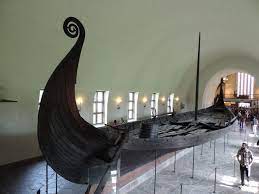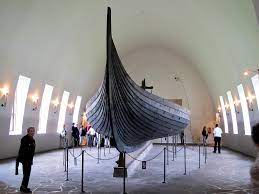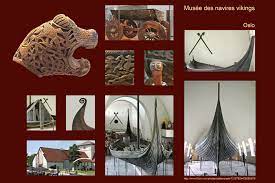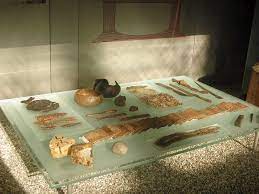Nestled along the tranquil shores of Oslo’s Bygdøy Peninsula, the Viking Ship Museum stands as a captivating portal into the rich history and seafaring legacy of the Vikings. This remarkable museum offers a serene and immersive experience, making it a must-visit destination for anyone seeking to delve into the intriguing world of the Vikings.
Getting to the Viking Ship Museum is a straightforward and delightful journey. From Oslo’s city center, you can take a short and scenic ferry ride across the fjord to Bygdøy. The ferry offers breathtaking views of Oslo’s waterfront and surrounding islands, setting the stage for the historical adventure that awaits.
Alternatively, you can reach the museum by bus or tram from the city center, with convenient stops on Bygdøy. The picturesque stroll from the ferry terminal or bus stop to the museum itself is an experience in itself, as you meander through lush green landscapes and along the peaceful coastline.

As you step inside the Viking Ship Museum, you’ll be greeted by the impressive sight of well-preserved Viking ships that date back over a thousand years. These ships, which include the Oseberg, Gokstad, and Tune ships, are the centerpiece of the museum’s collection. They are displayed in a climate-controlled environment that helps protect these historical treasures. As you step across the threshold of the Viking Ship Museum in Oslo, you embark on a captivating journey through time, where the past comes alive in the form of awe-inspiring Viking artifacts. The heart of the museum’s collection beats with the rhythmic tales of legendary Viking ships, each a testament to the seafaring prowess of these ancient mariners.
The centerpiece of this historical treasury is the triumvirate of Viking ships, each dating back over a millennium. The Oseberg, Gokstad, and Tune ships loom impressively within the museum’s chambers, their elegant lines and intricate craftsmanship a testament to the skill and artistry of the Viking shipbuilders. The Oseberg ship, with its graceful curves and intricate carvings, invites you to admire the mastery of Viking shipwrights. It once carried nobles on their final journey and now stands as an enduring symbol of Viking funerary customs. The Gokstad ship, with its imposing size and robust construction, speaks of Viking ambition and seafaring adventures. It bears witness to the journeys that took these fearless explorers as far as the distant lands of the Mediterranean and beyond. The Tune ship, while more modest in size, echoes the stories of Viking trade and commerce. Its presence reminds us of the extensive network of trade routes that the Vikings navigated with unmatched skill.
To ensure the preservation of these irreplaceable treasures, the Viking ships are displayed in a meticulously controlled climate environment. This controlled setting safeguards the wood, leather, and other materials that constitute these maritime marvels, allowing visitors to witness their splendor in a state of remarkable preservation.
Viking Life: A Window into the Past
Beyond the awe-inspiring ships, the Viking Ship Museum is a treasure trove of knowledge, offering visitors the opportunity to delve deep into the heart of Viking society and culture. The exhibits within the museum provide a multifaceted exploration of Viking life, illuminating their daily routines, customs, and traditions. As you wander through the halls, you’ll encounter an array of artifacts that peel back the layers of time and offer intimate glimpses into the lives of these seafaring people. Tools, textiles, and personal belongings are displayed with meticulous attention to detail, inviting you to step into the shoes of a Viking. Textiles, intricately woven and adorned with ancient patterns, tell stories of Viking craftsmanship and artistry. The garments, often adorned with ornate brooches and buckles, reveal the fashion sensibilities of the era. Weapons and armor, displayed with solemnity, provide insights into Viking military prowess and the importance of defense in a world marked by both trade and conflict. The meticulous craftsmanship of these implements serves as a testament to the reverence the Vikings held for their weaponry. Household items, from cookware to combs, illustrate the everyday aspects of Viking life. These humble artifacts demonstrate the practicality and resourcefulness of a society that relied on self-sufficiency.
Intriguingly, the museum’s exhibits offer more than a mere collection of objects. They serve as windows into the intricate tapestry of Viking society, revealing their values, customs, and interactions. It’s an immersive experience that allows you to step back in time and gain a profound understanding of the people who once ruled the seas.
A Relaxing Place by the Sea
The Viking Ship Museum’s location by the sea adds an extra layer of tranquility to the visitor’s experience. The calm waters of the fjord provide a soothing backdrop to the historical artifacts within the museum. You can sit by the shore, feel the gentle sea breeze, and soak in the serene ambiance.
During the warmer months, the museum’s waterfront area becomes a haven for relaxation. Visitors often bring blankets or picnic baskets to enjoy a meal while gazing out over the tranquil waters. It’s a serene and contemplative space, where you can reflect on the mysteries and marvels of Viking history.
In conclusion, the Viking Ship Museum in Oslo is a captivating destination that combines history, culture, and natural beauty. Whether you arrive by ferry, bus, or tram, the journey to this tranquil coastal museum is part of the experience. It offers a relaxing and immersive opportunity to explore the seafaring world of the Vikings while enjoying the serenity of Oslo’s waterfront.
Souvenir with a Story
When you visiting Norway, you must get a Norwegian Sweater. These sweaters are not only beautiful they are super warm and will last you a lifetime. In Norwegian, you would refer to a Norwegian sweater as “norsk genser” or “norsk strikkagenser.” “Norsk” means “Norwegian,” and “genser” or “strikkagenser” means “sweater.” So, you can say: “Norsk genser” or “Norsk strikkagenser”. Norwegian sweaters, often referred to as “Norwegian jumpers” or “Norwegian knitwear,” are renowned worldwide for their exceptional quality, intricate patterns, and unparalleled craftsmanship. While they may indeed come with a higher price tag when purchased in Norway, their expense is justified by the remarkable blend of tradition, durability, and timeless style they offer. Authentic Norwegian sweaters are often hand-knitted or machine-knitted with meticulous attention to detail. The craftsmanship involved in creating these garments is a labor of love that has been passed down through generations. Skilled artisans take pride in their work, ensuring each sweater meets the highest standards of quality and authenticity. Norwegian sweaters are typically made from premium natural materials such as pure wool, often sourced from local sheep breeds. This not only ensures warmth and comfort but also contributes to the durability and longevity of the sweater. The use of high-quality materials ensures that these sweaters can withstand the harshest of Nordic winters. The iconic Norwegian sweater design, featuring intricate patterns inspired by nature, history, and culture, is a testament to the country’s heritage. These patterns are not just aesthetically pleasing but also meaningful, often representing elements like fisherman’s ropes, snowflakes, and folk motifs. The timeless design ensures that these sweaters remain stylish for years to come.
Beyond their visual appeal, Norwegian sweaters are designed with practicality in mind. They are exceptionally warm and insulating, making them ideal for cold weather. Whether you’re out in the mountains or strolling through a city in winter, these sweaters keep you cozy and comfortable. Norwegian sweaters are versatile pieces of clothing. They can be worn casually or dressed up, making them suitable for various occasions. From outdoor adventures to cozy evenings by the fireplace, these sweaters are a wardrobe staple. High-quality Norwegian sweaters are built to last. They are not fast fashion items but rather investments in enduring style and quality. Their longevity contributes to sustainability, as they don’t need frequent replacement.
In conclusion, Norwegian sweaters are a testament to the country’s commitment to preserving its cultural heritage and traditions. While they may be more expensive in Norway, their worth goes beyond their price tag. These sweaters are timeless, warm, versatile, and deeply connected to the heart and soul of Norway. They represent an investment in both practicality and memorability, making them a cherished and enduring part of any wardrobe and a cherished souvenir of a visit to this beautiful country. Purchasing a Norwegian sweater in Norway is not just a transaction; it’s an opportunity to take home a piece of Norwegian culture and tradition. It’s a tangible way to connect with the country’s heritage and create lasting memories of your visit.









